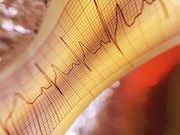Immediate versus delayed monitoring results in increased a-fib diagnosis rate in high-risk individuals
TUESDAY, July 17, 2018 (HealthDay News) — Immediate monitoring with a self-applied wearable electrocardiogram (ECG) patch results in a higher rate of atrial fibrillation (AF) diagnosis among individuals at high risk, according to a study published in the July 10 issue of the Journal of the American Medical Association.
Steven R. Steinhubl, M.D., from the Scripps Translational Science Institute in La Jolla, Calif., and colleagues conducted a direct-to-participant randomized trial and prospective matched observational cohort study to examine the impact of a self-applied wearable ECG patch in detecting AF. For the clinical trial, 2,659 individuals were randomized to active home-based monitoring to start immediately or after a four-month delay. In the observational study, two controls were selected for each actively monitored individual (1,738 actively monitored individuals and 3,476 controls).
The researchers found that new AF was identified by four months in 3.9 and 0.9 percent of the immediate and delayed groups, respectively, in the randomized study. At one year, AF was diagnosed in 6.7 and 2.6 per 100 persons-years among monitored and unmonitored individuals, respectively. Active monitoring correlated within increased initiation of anticoagulants, outpatient cardiology visits, and primary care visits. There was no difference in AF-related emergency department visits and hospitalizations.
“Among individuals at high risk for AF, immediate monitoring with a home-based wearable ECG sensor patch, compared with delayed monitoring, resulted in a higher rate of AF diagnosis after four months,” the authors write.
Several authors disclosed ties to pharmaceutical companies, including Janssen, which funded the study.
Copyright © 2018 HealthDay. All rights reserved.








